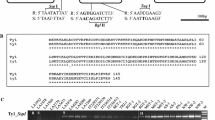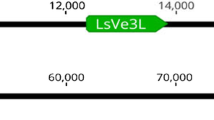Abstract
Accessions of wild Lycopersicon germplasm were screened for resistance to Pseudomonas syringae pv tomato (P.s. tomato). Resistance to both race-0 and race-1 strains of P.s. tomato was identified in L. pimpinellifolium, L. peruvianum and L. hirsutum var. glabratum. Resistance to race-0 derived from L. hirsutum var. glabratum (Pto3) appeared to be inherited independently of Pto1 and Pto2. Filial and backcross generations derived from interspecific crosses between L. esculentum and L. hirsutum var. glabratum revealed that Pto3 resistance was inherited in a complex fashion and was incompletely dominant under conditions of high bacteria inocula. Resistance to P.s. tomato race-1 (Pto4) was also identified in L. hirsutum var. glabratum. Pto3 and Pto4 segregated independently of each other.
Similar content being viewed by others
References
Banerjee MK, Kalloo (1987) Inheritance of tomato leaf curl virus resistance in Lycopersicon hirsutum F. glabratum. Euphytica 36:581–584
Bowles DJ (1990) Defense-related proteins in higher plants. Annu Rev Biochem 59:873–907
Flor HH (1956) The complementary genetic system in flax and flax rust. Adv Genet 8:29–54
Gilbert JC, McGiure DC (1952) Root knot resistance in commercial type tomatoes in Hawaii. Proc Am Soc Hortic Sci 60:401–411
Gilbert JC, McGuire DS (1956) Inheritance of resistance to severe root knot from Meloidogyne incognita in commercial-type tomatoes. Proc Am Soc Hortic Sci 68:437–442
Hassan AA, Mayzayd HM, Moustafa SE, Nassar SH, Nakhla MK, Sims WL (1984) Inheritance of resistance to tomato leaf curl virus derived from Lycopersicon cheesmanii and Lycopersicon hirsutum. Hortscience 19:574–575
King EO, Ward NK, Raney DE (1954) Two simple media for the demonstration of pyrocyanin and fluorescein. J Lab Clin Med 44:301–307
Lawson VF, Summers WL (1984) Resistance to Pseudomonas syringae pv tomato in wild Lycopersicon species. Plant Dis 68:139–141
Lawton MB, MacNeill BH (1986) Occurrence of race-1 of Pseudomonas syringae pv tomato on field tomato in southwestern Ontario. Can J Plant Pathol 8:85–88
Leppik EE (1970) Gene centers of plants as sources of disease resistance. Annu Rev Phytopathol 8:323–324
Lunne JM, Wood D (1991) Plant diseases and the use of wild germplasm. Annu Rev Phytopathol 29:35–63
Martin GB, Brommonschenkel SH, Chunwongse J, Frary A, Ganal MW, Spivey R, Wu T, Earle ED, Tanksley SD (1993) Map-based cloning of a protein kinase gene conferring disease resistance in tomato. Science 262:1432–1436
Martin MW (1970) Developing tomatoes resistant to curly top virus. Euphytica 19:243–252
Maxon-Smith KW (1977) Lycopersicon hirsutum as a source of genetic variation for the cultivated tomato. Proc 8th Congr Eucarpia. Madrid, Spain, pp 119–128
Pilowski M, Zutra D (1982) Screening wild tomatoes for resistance to bacterial speck pathogen (Pseudomonas tomato). Plant Dis 66:46–47
Pilowski M, Zutra D (1986) Reaction of different tomato genotypes to the bacterial speck pathogen (Pseudomonas syringae pv tomato). Phytoparasitica 14:39–42
Pitblado RE, Kerr EA (1980) Resistance to bacterial speck (Pseudomonas tomato) in tomato. Acta Hortic 100:379–382
Rick CM (1979) Biosystematic studies in Lycopersicon and closely related species of Solanum. In: Hawkes JG, Lester RN, Skelding AD (eds) The biology and taxonomy of the Solanaceae. Academic Press, London, pp 667–678
Rick CM (1980) Tomato. In: Fehr WR, Hadley HH (eds) Hybridization of crop plants. American Society of Agronomy-Crop Science Society of America, Madison, Wisconsin, pp 669–680
Rick CM, DeVerna JW, Chetelat RT, Stevens MA (1987) Potential contributions of wide crosses to improvement of processing tomatoes. Acta Hortic 200:45–55
Ronald PC, Salmeron JM, Carland FM, Staskawicz BJ (1992) The cloned avirulence gene avrPto induces disease resistance in tomato cultivars containing the Pto resistance gene. J Bacteriol 174:1604–1611
Sotirova VG, Bogatsevska N (1990) Reaction of wild species and varieties of the Lycopersicon genus to race-0 and race-1 of Pseudomonas syringae pv tomato (Okabe) Young et al. C R Acad Bulg Sci 43:89–91
Tanksley SD, Ganal MW, Prince JP, de Vincente MC, Bonierbale MW, Broun P, Fulton TM, Giovannoni JJ, Grandillo S, Martin GB, Messeguer R, Miller JC, Miller L, Paterson AH, Pineda O, Röder MS, Wing RA, Wu W, and Young ND (1992) High density molecular linkage maps of the tomato and potato genomes. Genetics 132:1141–1160
Thompson JN, Burdon JJ (1992) Gene-for-gene coevolution between plants and parasites. Nature 360:121–125
Watts VM (1947) The use of Lycopersicon esculentum as a source of nematode resistance in tomatoes. Proc Am Soc Hortic Sci 49:233–234
Author information
Authors and Affiliations
Additional information
Communicated by M. Koornneef
Rights and permissions
About this article
Cite this article
Stockinger, E.J., Walling, L.L. Pto3 and Pto4: novel genes from Lycopersicon hirsutum var. glabratum that confer resistance to Pseudomonas syringae pv tomato . Theoret. Appl. Genetics 89, 879–884 (1994). https://doi.org/10.1007/BF00224513
Received:
Accepted:
Issue Date:
DOI: https://doi.org/10.1007/BF00224513




